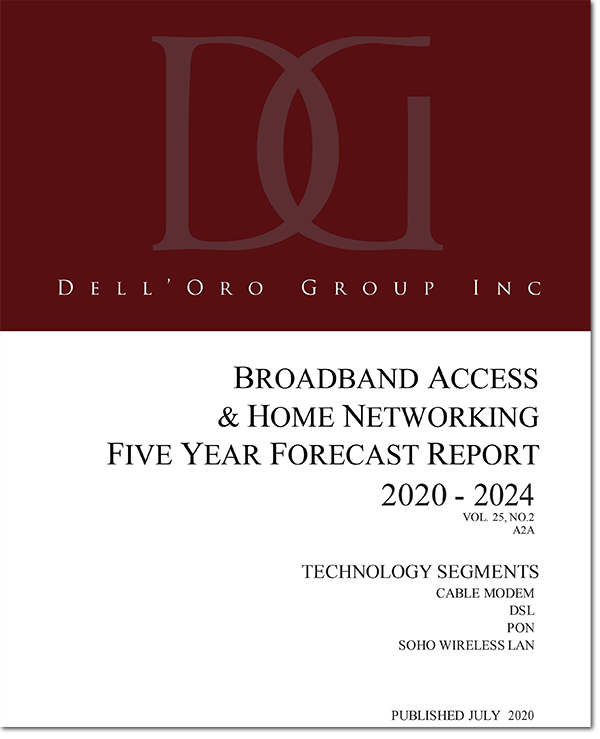 Global Headwinds in 2020 Give Way to 2021 Expansion
Global Headwinds in 2020 Give Way to 2021 Expansion
Global spending on broadband access equipment and CPE is expected to drop 7% in 2020, dipping to $11.4 B, before increasing 5% in 2021. Our forecast from January 2020 anticipated a 5% decline in total revenue in 2020.
More interestingly, we have increased our five-year CAGR (2019-2024) from -2% from our January forecast to -0.9%. This improvement might seem counterintuitive, given the worldwide impact of the COVID-19 pandemic. However, the pandemic and its resulting orders to stay at home for work and education, have shown the world just how critical adequate broadband access is to the global economy. As a result, global initiatives to expand and improve broadband access are either underway or will be shortly. Nearly all service providers have said that they have reached their planned capacity utilization rates for the entire year in the first half of 2020. Thus, they will need to expand this capacity to maintain comfortable operating levels. However, operators will do so judiciously, as subscriber growth might be short-lived and the pressure to preserve to capital, or to ensure capital is balanced in the midst of expanding RAN investments, becomes fundamentally more important than overall expansion.
PON Equipment Spending Expected to Remain Solid
Our five-year CAGR for PON equipment has been increased from 0% to just under 1%. China, which has historically accounted for anywhere from 65-80% of total PON spending, has peaked in terms of total ONT units consumed on an annual basis. The Chinese FTTH market has matured, with broadband penetration in the country reportedly nearing 80%. Though subscriber growth is slowing, there is still a tremendous installed base of subscribers that will continue to require new ONTs. This is especially the case beginning this year, when all three major operators begin purchasing 10 G units, based on either 10G EPON or the asymmetric XG-PON1 technologies. The 10 G upgrade cycle in China for ONTs will be extended over a longer period of time than the initial 1G EPON and 2.5 G GPON rollouts, as individual systems announce gigabit city initiatives.
Although China’s ONT volumes are coming down from the peak years of 2017 and 2018, additional growth is expected from the rest of the world—particularly North America and Western Europe. In North America, the FCC’s $20B RDOF (Rural Digital Opportunity Fund) program will help transition a significant number of rural areas to fiber. In Western Europe, major operators including Orange, DT, BT OpenReach, and Proximus are all expanding their fiber rollouts and even moving quickly to XGS-PON for symmetric 10 G services.
Finally, in Asia, India, Indonesia, and Malaysia, along with a 10 G upgrade cycle in Japan and South Korea should also help sustain the market.
After 2019-2020 Trough, Cable Equipment Spending Expected to Rebound
The glut of DOCSIS channel capacity that helped push down cable equipment revenue in 2019 has actually been beneficial to operators this year as they have been able to address significant increases in both upstream and downstream traffic during the pandemic with minimal increases in spending. In most cases, cable operators have used the software tools available as part of DOCSIS 3.1 to ensure adequate bandwidth for all subscribers. In other cases, operators have purchased additional DOCSIS licenses as part of accelerated node split programs to address systems with the greatest need.
But all those investments in existing CCAP platforms have resulted in postponements of strategic DAA projects, for the time being. We have no doubt these projects will resume, but it won’t likely be until the latter part of this year or 2021 before they do.
Regardless, after two years of under-investing in infrastructure, the overall cable infrastructure market will see a steady increase in revenue throughout our forecast period, as mid- and high-split projects in North America and Western Europe, designed to increase upstream capacity, are accelerated.
To get a copy of the Broadband Access July 2020 5-Year Forecast Report, please email us at dgsales@delloro.com.
About the Broadband Access 5-Year Forecast Report:
The Dell’Oro Group Broadband Access 5-Year Forecast Report provides a complete overview of the Broadband Access market with tables covering manufacturers’ revenue, average selling prices, and port/unit shipments for Cable, DSL, and PON equipment. Covered equipment includes Converged Cable Access Platforms (CCAP), Distributed Access Architectures (DAA), DSL Access Multiplexers ([DSLAMs] by technology ADSL/ADSL2+, G.SHDSL, VDSL, VDSL Profile 35b, G.FAST), PON Optical Line Terminals (OLTs), Customer Premises Equipment ([CPE] for Cable, DSL, and PON), along with SOHO WLAN Equipment, including Mesh Routers.

 Let’s face it, cable equipment vendors are certainly happy to put 2019 behind them. A glut of DOCSIS channel capacity, the lack of significant competitive threats, and indecision around DAA technologies and timing all resulted in a spending slowdown that lopped off 35% of total DOCSIS infrastructure revenue, year-over-year. Traditional, centralized CCAP platforms bore the brunt of the reductions, with total revenue down 41% year-over-year.
Let’s face it, cable equipment vendors are certainly happy to put 2019 behind them. A glut of DOCSIS channel capacity, the lack of significant competitive threats, and indecision around DAA technologies and timing all resulted in a spending slowdown that lopped off 35% of total DOCSIS infrastructure revenue, year-over-year. Traditional, centralized CCAP platforms bore the brunt of the reductions, with total revenue down 41% year-over-year.